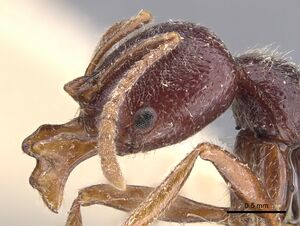Myopias lobosa
| Myopias lobosa | |
|---|---|

| |
| Scientific classification | |
| Kingdom: | Animalia |
| Phylum: | Arthropoda |
| Class: | Insecta |
| Order: | Hymenoptera |
| Family: | Formicidae |
| Subfamily: | Ponerinae |
| Tribe: | Ponerini |
| Genus: | Myopias |
| Species: | M. lobosa |
| Binomial name | |
| Myopias lobosa Willey & Brown, 1983 | |
Nothing is known about the biology of Myopias lobosa.
Identification
Willey and Brown (1983) - Worker and queen: Head distinctly longer than broad; median clypeal process obsolete; labrum without median tubercle. Mandibles much broadened, each with the two major teeth before the apex exaggerated into triangular lobes; blades of mandibles sharply curved ventrad and rotated so that their blades lie nearly parallel to the sagittal plane of the head at full closure. Antennal scapes very short. Sculpture composed of distinct punctures, fine and densely arranged on cephalic dorsum, with smooth to finely shagreened interspaces.
Keys including this Species
Distribution
Latitudinal Distribution Pattern
Latitudinal Range: 9.3023° to 6.733167°.
| North Temperate |
North Subtropical |
Tropical | South Subtropical |
South Temperate |
- Source: AntMaps
Distribution based on Regional Taxon Lists
Indo-Australian Region: Philippines (type locality).
Distribution based on AntMaps
Distribution based on AntWeb specimens
Check data from AntWeb
Countries Occupied
| Number of countries occupied by this species based on AntWiki Regional Taxon Lists. In general, fewer countries occupied indicates a narrower range, while more countries indicates a more widespread species. |

|
Estimated Abundance
| Relative abundance based on number of AntMaps records per species (this species within the purple bar). Fewer records (to the left) indicates a less abundant/encountered species while more records (to the right) indicates more abundant/encountered species. |

|
Biology
Castes
Worker
  
| |
| . | Owned by Museum of Comparative Zoology. |
Images from AntWeb

| |
| Paratype of Myopias lobosa. Worker. Specimen code casent0902528. Photographer Will Ericson, uploaded by California Academy of Sciences. | Owned by NHMUK, London, UK. |
Nomenclature
The following information is derived from Barry Bolton's Online Catalogue of the Ants of the World.
- lobosa. Myopias lobosa Willey & Brown, 1983: 277, figs. 2, 3, 25 (w.q.) PHILIPPINES (Negros I.).
- Type-material: holotype worker, 6 paratype workers, 1 paratype queen.
- Type-locality: holotype Philippines: Negros, Cuernos Mts, nr Dumaguete (Chapman); paratypes with same data.
- Type-depositories: MCZC (holotype); BMNH, MCZC (paratypes).
- Status as species: Bolton, 1995b: 269; Xu, Burwell & Nakamura, 2014b: 165 (in key); Probst, Guénard & Boudinot, 2015: 204 (in key).
- Distribution: Philippines (Negros).
Unless otherwise noted the text for the remainder of this section is reported from the publication that includes the original description.
Description
Worker
Holotype and six paratypes from type nest series: TL 6.0-6.3, HL 1.27-1.31, HW 0.98-1.04 (CI 76-82), ML 0.76-0.78 (MI 75-83), SL 0.74-0.77 (SI 75-80), EL 0.22-0.25, WL 2.01-2.09 mm.
Head with gently convex subparallel sides, straight to feebly convex occipital border, and broadly rounded posterior angles. Greatest head width slightly behind mid length. Eyes oval, only feebly convex, their greatest diameter great her than maximum width of scape; about 12-15 fine facets in rows across the short axis; eye separated from anterior corner of head by about 2/3 its own length or slightly more. Frontal sulcus extends slightly beyond mid length of head. Median clypeal process obsolete, represented only by a weak convexity between the frontal lobes with two or three minute piligerous tubercles. Form of mandibles shown in Figs. 2, 3. Scapes reaching roughly to about 3/4 the distance between their insertions and the occipital border; segment I of funiculus distinctly longer than II; II through X increasing rather uniformly in size, so that no club is formed.
Trunk as seen from side forming gentle, subequal promesonotal and propodeal convexities, separated by the impressed metanotal groove. Petiolar node slightly higher than long seen from the side (without subpetiolar process) and very slightly longer than broad seen from above. Postpetiolar segment seen from above about 4/5 as long as broad, slightly shorter than the succeeding segment.
Dorsum of head densely sown with fine, uneven-sized punctures, close together, but interspaces mostly smooth and shining; region posteromesad of compound eyes with densest punctation. Sides and underside of head smooth and shining and with scattered coarse punctures. Mandibles, gastric apex, scapes and legs smooth and shining.
Trunk, petiole, and first two gastric segments with numerous coarse, mostly elongate piligerous punctures. Between punctures the integument is mostly smooth to shagreened on the dorsum, becoming striolate and subopaque on sides and rear of trunk and petiolar node, and to some extent on mesonotum and propodeal dorsum.
Pilosity of fine, tapered, erect hairs, moderate in length and generally distributed. Head with abundant, mesally directed decumbent pubescence over most of the dorsum; scapes and legs with similar pubescence, directed apicad. Color bright to deep brownish-red; mandibles and appendages lighter, more yellowish.
Queen
Dealate: slightly larger than the worker. Flight sclerites and wing stumps well developed. Petiolar nodes slightly broader than long as seen from above. Mesonotum and propodeum shagreened (finely reticulate) above and with scattered coarse punctures. Ocelli small. Compound eyes large; maximum diameter ca. 1/5 the full head length (HL).
Type Material
Holotype (Museum of Comparative Zoology) a worker from a uninidal series of 7 workers and a queen from the Cuernos Mts., near Dumaguete, Negros, Philippine Islands (Chapman). Paratype workers from the same colony (MCZ, The Natural History Museum).
References
References based on Global Ant Biodiversity Informatics
- Xu Z.-H.; C. J. Burwell., and A. Nakamura. 2014. A new species of the ponerine ant genus Myopias Roger from Yunnan, China, with a key to the known Oriental species. Sociobiology 61(2): 164-170.

